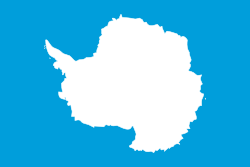Flag designs
Since the 1970s, there have been many designs proposed as a flag for Antarctica. [1]
White flag (1929)

In 1929, members of the British Australian and New Zealand Antarctic Research Expedition on RRS Discovery used white cotton sheeting to improvise a courtesy ensign for Antarctica, which had (and currently has) no official flag. The banner is now in the National Maritime Museum in London. The white flag was used to represent Antarctica on at least two occasions on the voyage to Antarctica. On 1 August 1929, The Times noted that "the ship was flying the Union Jack at her forepeak, the white Antarctic flag at the foremast, and the Australian flag at the stern." [2] [3]
Whitney Smith's proposal (1978)

Vexillologist Whitney Smith presented an orange flag with a white emblem in the hoist at the 1978 annual meeting of the North American Vexillological Association (NAVA). The letter A stands for Antarctica, the semi-sphere represents the area below the Antarctic Circle, and the hands represent human protection of the environment. For high visibility, he chose international orange, a color commonly used in the aerospace industry to set objects apart from their surroundings. [1] The bright orange color was also chosen due to its rarity among national flags, as no nation with an active research base on the continent uses the color orange in their flag. The design elements are positioned on the hoist side of the flag so that it would remain visible even if the flag were damaged by the harsh Antarctic winds. [4]
Graham Bartram's proposal (1996)

Graham Bartram, the chief vexillologist of a British organization, the Flag Institute, designed another proposal in 1996 for a 3D Atlas program developed by The MultiMedia Corporation and published by Electronic Arts. [5] Using the flag of the United Nations as his model, he chose a plain white map of the continent on a blue background to symbolize neutrality. The flag was inspired by the emblem of the Antarctic Treaty System. [6]
Vexillologist Ted Kaye had Bartram's design printed and took them with him on an Antarctic cruise. At Kaye's request, it flew at the Brazilian base Comandante Ferraz and the British museum at Port Lockroy. [1] Since 2015, Bartram's design has been used on most supported platforms as the "Flag of Antarctica" emoji implemented using the regional indicator symbol sequence AQ. [7]
Redesign
In a 2024 update to his design, Bartram introduced modifications to the flag which were aimed at raising awareness about the environmental challenges facing the continent, specifically focusing on the issue of microplastic pollution. This initiative seeks to highlight the presence of microplastics in Antarctica, drawing global attention to the impact on wildlife and ecosystems and advocating for international efforts to tackle this pressing issue. [8]
True South proposal (2018)

The True South proposal was designed by Evan Townsend in 2018. [9] [10] The flag has the following meaning:
Horizontal stripes of navy and white represent the long days and nights at Antarctica's extreme latitude. In the center, a lone white peak erupts from a field of snow and ice, echoing those of the bergs, mountains, and pressure ridges that define the Antarctic horizon. The long shadow it casts forms the unmistakable shape of a compass arrow pointed south, an homage to the continent's legacy of exploration. Together, the two center shapes create a diamond, symbolizing the hope that Antarctica will continue to be a center of peace, discovery, and cooperation for generations to come. [11]
The flag is named after geographic South, or "true South", which differs from magnetic south. [12]
The flag has quickly gained popularity since its introduction. [13] It has been adopted by a few National Antarctic Programs, [14] [15] Antarctic nonprofits, and expedition teams; flown at several research stations across Antarctica; [16] and was used in the 2022 marker for the geographic South Pole. [17] The flag is also used as the flag of Antarctica by the CIA World Factbook. [18]



